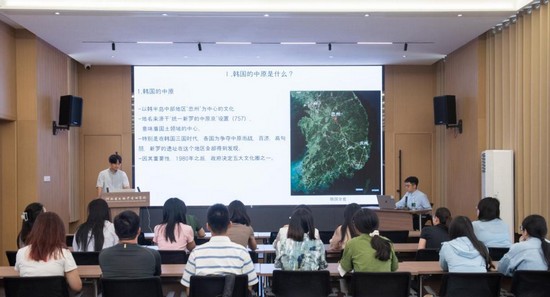Scholar from Korean Jungwon National Research Institute of Cultural Heritage Was Invited to HPICHA for Academic Exchange
Date Posted: 2024-09-14


Since 2012, Henan Provincial Institute of Cultural Heritage and Archaeology (HPICHA) and Jungwon National Research Institute of Cultural Heritage of the Republic of Korea have been carrying out academic exchanges and conducting collaborative researches in the field of ancient civilization and cultural heritage of China and the Republic of Korea. During the cooperation period, such events have provided a valuable cooperation platform for scholars from both countries that may broaden their academic horizons, and greatly promote academic exchanges.

To further promote academic exchange and cooperative research in the field of ancient cultures between China and the Republic of Korea, HPICHA held a seminar themed “Cooperative Research on the Formation and Development of Chinese and Korean Cultures of Central Plains” on September 11, 2024, during which Lee Soleon, Research Fellow of Jungwon National Research Institute of Cultural Heritage of Korea Heritage Service, was invited to give a thematic lecture titled “Iron and Fire: A Preliminary Discussion on the Wrought Iron Technology in the Central Plains of Korea—Taking the Archaeological Site of Chungju Chilgeum-dong as an Example.”
Li Qin, HPICHA’s Executive Director, delivered a short speech before this academic lecture.

Li Qin addresses before the lecture.
Based on the ancient iron smelting production remains discovered at the Archaeological Site of Chungju Chilgeum-dong, Lee Soleon’s report provides a comparative study of the iron smelting technology in the Central Plains of China and Korea, focusing on the significant roles that Chungju in Korea and Zhengzhou in China played in ancient iron smelting production activities. The report introduces the origins, development, and characteristics of wrought iron manufacturing technology in ancient Korea. At present, 16 iron smelting remains have been discovered in the Central Plain of Korea, among which some remains including iron smelting furnaces, furnace walls, slag, iron ores and, iron implements have been found in the four archaeological researches conducted in the Archaeological Site of Chungju Chilgeum-dong. Preliminary research findings show that the iron smelting technology in ancient Korea may be related to that in Northeast China and Lelang during the Han Dynasty (206 BC-220 AD). However, limited by the archaeological excavation materials, there is currently a lack of comparative materials with the iron smelting furnaces in the archaeological site of Chilgeum-dong, and the understanding of iron smelting technology in the Central Plain of Korea needs more and further researches.

Lee Soleon is delivering the academic lecture.


In the discussion session of the lecture, the scholars present at the seminar discussed such questions as the similarities and differences of ancient iron smelting technology between China and the Republic of Korea, as well as the significant ancient Korean iron smelting remains.
Dr. Zhao Runyu served as the interpreter for this academic lecture.







